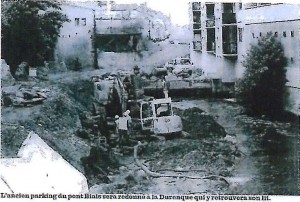|
The major development project for the banks of the Durenque in order to limit flood impact is now well under way.
Very much on the fore scene today, this project required several years' preparation but the excavators and bulldozers eventually moved in
Le plus spectaculaire reste bien entendu la modification de l’embouchure de la Durenque au niveau de la nouvelle résidence du pont Biais.
Until now, the river was deviated towards a channel running under the building to make space for a parking lot.
The city of Castres has undertaken to modify the mouth of the river in order to restore the Durenque to its original course, which runs along the back of the building before flowing into the Agoût. Jean-Louis Deljarry, an engineer working for the City's Public Service Department, explains: "Companies are now recalibrating the space; it will then be necessary to build a bridge at the back of the building to allow access to first aid services and fire brigades. I believe the Durenque will be restored to its course by the Fall." »
|

After completing the demolition phase, it is time to recalibrate the bed of the Durenque. The most spectacular part is located around the Pont Biais apartment building, where the river is to be restored to its original course.
|
The two other hotspots of this programme are situated upriver from the Pont Emilie de Villeneuve.
The first one involves recalibrating the river along the rue Anne Veaute. Several old, run-down buildings have been bought from their owners and demolished, making it possible for the river bed to be widened and absorb more water. The city of Castres has seized this opportunity to modify the largest wastewater pumping station in the city center, building an underground holding pool that will prevent any overflowing into the river.
|
Additionnally, the redevelopment project for the space left vacant by the former Plo factory is also under way. The green areas and 40-space parking lot to be built there will also play a preventive role by acting as a flood expansion area in case of a crisis.
The whole works amount to a dizzying 3,4 million euros, but the stakes are also high: to many, the investment is well worth the assurance of not having to live through devastating floods like those of 1996 and 1999.
Jean-Marc Guilbert
|
|
